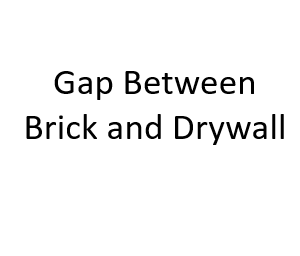When it comes to construction and home improvement, the devil is often in the details. One common issue that homeowners and builders face is the gap between brick and drywall. This seemingly small gap can lead to a host of problems if not properly addressed. In this blog post, we’ll dive deep into understanding the gap between brick and drywall, its causes, potential issues, and effective solutions. By the end, you’ll be equipped with the knowledge to bridge this gap and ensure the structural integrity and aesthetics of your walls.
Understanding the Gap
The gap between brick and drywall is a space that separates the exterior brick walls from the interior drywall. This gap serves several important functions:
- Insulation: The gap can act as a thermal barrier, helping to regulate the temperature inside your home.
- Soundproofing: It can also provide some level of soundproofing by reducing the transfer of sound from outside to inside and vice versa.
- Movement: The gap accommodates the natural expansion and contraction of materials due to temperature and humidity changes, preventing damage to the walls.
- Moisture Control: It allows for drainage of any moisture that might accumulate behind the brick facade, preventing water damage.
Causes of the Gap
- Construction Design: The gap is intentionally designed into many buildings to serve the purposes mentioned earlier.
- Settling and Shifting: Over time, a building can settle or shift slightly, creating or exacerbating the gap.
- Inadequate Installation: Poor construction practices can lead to gaps that are larger than intended.
Potential Issues
Ignoring or neglecting the gap between brick and drywall can lead to a range of problems:
- Energy Loss: A poorly sealed gap can result in energy loss, causing higher heating and cooling bills.
- Pest Intrusion: Insects and rodents may find their way into your home through gaps in the wall.
- Moisture Damage: If water enters the gap and isn’t properly drained, it can lead to mold growth, rot, and structural damage.
- Aesthetic Concerns: Gaps can be unsightly, disrupting the appearance of your walls.
Effective Solutions
- Sealing the Gap: One of the most common solutions is to seal the gap between brick and drywall using caulk or foam insulation. This helps with insulation, soundproofing, and preventing pest intrusion.
- Weatherstripping: Installing weatherstripping or gaskets around doors and windows can help reduce energy loss through gaps.
- Regular Maintenance: Periodic inspection and maintenance of the gap can prevent moisture damage and other issues. Look for cracks, gaps, or signs of water infiltration.
- Consult a Professional: If you suspect significant structural issues related to the gap, it’s advisable to consult a professional contractor or engineer for a thorough assessment and repair plan.
Additional Considerations
While sealing and maintaining the gap between brick and drywall are crucial steps in preserving your home’s integrity, there are some additional considerations to keep in mind:
- Materials Matter: When choosing sealants or insulation for the gap, select high-quality materials that are designed for your specific needs. Ensure they are durable and capable of withstanding temperature fluctuations and moisture.
- Ventilation: Adequate ventilation behind the brick facade is essential to prevent moisture buildup. Proper ventilation systems can help mitigate the risk of mold growth and structural damage.
- Professional Assistance: For older homes or buildings with significant structural issues related to the gap, consulting a structural engineer or contractor is advisable. They can provide tailored solutions and ensure the gap is properly sealed without compromising the building’s integrity.
- Energy Efficiency: To enhance your home’s energy efficiency, consider adding insulation to the gap. This can significantly reduce heating and cooling costs over time, making it a worthwhile investment.
- Cosmetic Solutions: If the appearance of the gap bothers you, there are cosmetic solutions available. Installing trim or molding can cover the gap and provide an aesthetically pleasing transition between brick and drywall.
DIY Tips
For those who enjoy tackling home improvement projects themselves, here are some DIY tips for addressing the gap between brick and drywall:
- Clean the Gap: Before applying any sealant or insulation, thoroughly clean the gap to ensure proper adhesion. Remove any dirt, dust, or debris.
- Choose the Right Sealant: Select a high-quality sealant that is compatible with both brick and drywall materials. Silicone or latex-based caulks are often suitable choices.
- Apply Evenly: Use a caulk gun or foam applicator to apply the sealant or insulation evenly along the gap. Smooth it out for a clean finish.
- Trim and Finish: If you’re adding trim or molding, measure and cut it to fit precisely. Secure it in place with nails or adhesive, and finish by painting or staining to match your interior decor.
- Regular Checks: After completing your DIY project, periodically check the sealed gap for any signs of wear or damage. Promptly address any issues that arise to maintain the integrity of your wall.
Final Thoughts
The gap between brick and drywall may seem like a minor detail in the grand scheme of construction, but it plays a vital role in the functionality and longevity of your home. Whether you’re focused on energy efficiency, aesthetics, or structural integrity, addressing this gap is a task that should not be overlooked.
By understanding the causes, potential issues, and effective solutions discussed in this comprehensive guide, you can take proactive steps to ensure that the gap between brick and drywall serves its intended purposes, making your home a comfortable and secure environment for years to come. Remember that proper maintenance and occasional professional consultation are key to keeping your walls in optimal condition.
